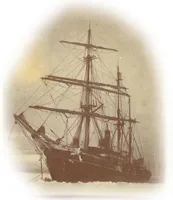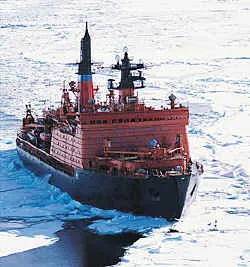The Ships of the Antarctic Explorers
Ships were the means by which the early explorers of Antarctica reached the continent and often over-wintered. They were very much the focus of Antarctic expeditions which were often named informally after the ship that took the men, their provisions and their equipment to Antarctica. Many landmarks in Antarctica are named after these vessels.
 In
the earliest days of Antarctic exploration, the vessels were
sailing ships, they rarely entered pack ice as the ships
means of propulsion was essentially the same as that of the
ice itself, so unless the ice dispersed, great difficulty
could be had in extracting the ship, these lessons had been
learned the hard way in the Arctic many years before.
In
the earliest days of Antarctic exploration, the vessels were
sailing ships, they rarely entered pack ice as the ships
means of propulsion was essentially the same as that of the
ice itself, so unless the ice dispersed, great difficulty
could be had in extracting the ship, these lessons had been
learned the hard way in the Arctic many years before.
Later on, with the advent of the screw propeller, ships became more able to enter, maneuver and make progress in pack ice. In particular they could break through ice by reversing a short distance and then going forwards again to ram it, repeating several times if required to break through.
The first ships able to do this were steam powered and this progress kind of through ice was very heavy on coal. As Antarctica is so far away from any port and supplies, for many years Antarctic vessels were hybrids of steam power and wind. Wind was used wherever possible to conserve the coal stocks for later on in the voyage.
Ideal Requirements for a Polar ship
-
Strong hull, to minimize damage from floating ice, to avoid being crushed by sea ice and to be able to push its way through the ice.
- Rounded hull to allow the ship to ride upwards
if pushed from the sides by wind-blown pack ice. The innocent
sounding event of being "nipped" by the ice could
easily end up crushing the ship and sinking it if it wasn't
able to escape the grip.
-
Re-inforced bows to withstand hitting against floating pack ice. Ideally re-inforced by massive structural strength and then clad in iron.
- Retractable propeller and rudder to
avoid ice damage.
- Skewed bows so that when hitting pack
ice the ship would ride up and over the ice breaking it
with its own weight.
- Powerful engines economical with fuel
for working in heavy ice.
- Well insulated on the inside to retain heat
and not allow moisture to drip inwards from frozen ice and
snow on the outside.
- Plenty of stowage space for scientific
cargo and provisions for at least a year longer than the
intended voyage - in case the ship was iced in.
- A good supply of ice anchors, long
(14ft) ice saws and maybe dynamite to break a passage through
winter ice to open water in the spring.
- Entertainments on board to pass the long dark winter months.


Ships Then and Now
A Comparison of Modern
with Heroic
Age Polar Ships
Some comparative statistics for polar vessels over almost 200
years arranged by date of launching. Where "original strengthening"
is marked for the hull, it refers to the fact that the hull
design was stronger than the normal for a ship of the time.
Note that until 1892, all ships had been built for some other
purpose and only used in the polar regions as a consequence
of their stronger than usual design features making them suitable
for work around ice.| Ship name | Length Breadth Draft, m |
Displacement | Launched | Design purpose |
Power | Hull |
|---|---|---|---|---|---|---|
| L'Astrolabe |
380 tons | 1811 | Naval corvette |
Sail only | Wooden | |
| Terror | 31.1 x 8.2 x 3.8 | 325 tons | 1813 | Shore bombardment |
Sail only fitted with 20hp engine in 1845 |
Wooden original strengthening + extra for Antarctic |
| Erebus | 32 x 8.7 x 4.2 | 372 tons | 1826 | Shore bombardment |
Sail only fitted with 20hp engine in 1845 |
Wooden original strengthening + extra for Antarctic |
| Nimrod | 41.5 x 8.2 x 4.9 | 334 tons | 1865 | Sealer | 60 nhp | Wooden original strengthening |
| Aurora | 50.3 x 9.3 x 5.7 | 380 tons | 1876 | Sealer | 98 nhp | Wooden original strengthening |
| Terra Nova | 57 x 9.6 x 5.8 | 744 tons | 1884 | Whaler | 140 nhp | Wooden original strengthening |
| Belgica | 36 x 7.6 x 4.1 | 336 tons | 1884 | Sealer | 30 nhp | Wooden original strengthening |
| Fram | 39 x 11 x 4.8 | 402 tons | 1892 | Arctic expedition |
220 hp | Wooden original strengthening |
| Discovery | 52.1 x 10.3 x 4.8 | 485 tons | 1901 | Antarctic expedition |
450 nhp | Wooden original strengthening |
| Endurance | 43.9 x 7.5 | 300 tons | 1912 | Arctic tours |
350 hp | Wooden original strengthening |
| James Clark Ross | 99 x 18.9 x 6.4 | 5,730 tonnes | 1990 | Antarctic supply and research |
8,500 shp | Steel original strengthening |
| Kapitan Khlebnikov | 132.4 x 27.8 x 8.5 | 15,000 tonnes | 1980 | Icebreaker | 24,200 hp | Steel original strengthening |
| Yamal | 150 x 30 x 11 | 23,455 tonnes | 1992 | Nuclear icebreaker |
75,000 shp | Steel original strengthening |
